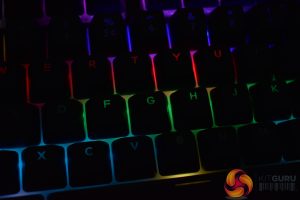To test the MS120 combo set, I used both the keyboard and the mouse together as my daily drivers. During this time, I played games, edited photos and generally used my PC as normal.
I'll break up my thoughts into dedicated sections for extra clarity. Both components ship software free.
Keyboard
I've seen a few keyboards from Cooler Master over the last year or so, though they have all been proper mechanical boards with Cherry MX switches. The MS120 is a ‘mem-chanical' board which essentially means Cooler Master has tried to make the plunger switches feel like you are using an actual mechanical board – so none of the mushy feedback from a membrane board – without physically using mechanical switches.
In practice, if you have experience with mechanical keyboards, you will not be fooled. These plunger switches don't have quite the same feel as their authentic counterparts as they are just slightly less rigid and overall less sturdy. However, of the many ‘mem-chanical' boards I have used, the MS120 keyboard is undoubtedly the best feeling. There is definite tactile feedback and an audible click, though the latter feature may well split opinion.
So, overall, the switches aren't as good as proper mechanical switches – I would never expect them to be. However, for a combo at this price, the switches feel surprisingly good and are satisfying to type with. They are definitely on the heavy side, though, as they feel like MX Blue switches.
In my opinion, this is not ideal for gaming as the heavier switches slow you down somewhat as each press simply requires more force. However, this is subjective and some people do like to game with heavier switches, but it is definitely worth noting.
Elsewhere, the on-board controls work very well. Using F1-F4 allows you to configure the RGB lighting, and overall it is very successful. There are plenty of effects to choose from – including rainbow, reactive and static modes – and it is very easy to get your desired colour using the on-board red, green and blue modifiers.
My only gripe with the lighting is the lack of a backlight brightness setting. The only way to turn off the backlight is to cycle through the different modes – there is no master brightness setting, and personally I just find that very annoying. I don't want to lose my current setting just to quickly dim, or turn off, the backlight, but Cooler Master makes you do that.
Lastly, it is worth touching on overall build quality. This is one area where I think Cooler Master does very well as their MasterKeys Pro boards are some of the toughest on the market. The MS120's board is still very rigid – for a board of this price at least – and there is only minimal flex to it. Cooler Master has again used a metal internal frame and this clearly pays dividends as the board is actually sturdier than many of its more expensive counterparts.
Mouse
Moving onto the MS120's mouse, I'll first start with the shape. It is certainly a wide and ergonomic design that may be off-putting to those with smaller hands. However, the design is overall quite clever as it allows both a palm grip and a claw grip to be used with ease – something which is vital for a bundle as the products have to be quite versatile to cater to everybody.
Personally speaking, I prefer a claw grip and was more than happy using the MS120 mouse like that. Like I said, though, a palm grip is equally comfortable, it is just not my preference.
I do wish there was some textured rubber on the right-hand side of the mouse, though, as that would've definitely helped overall grip retention. At the minute, there is just some hard plastic for your thumb to rest against and that is not ideal.
Another area worth noting is the choice of optical sensor. Cooler Master has gone with the PixArt PMW 3050 optical sensor, with a maximum DPI of 3500. Now, the PMW 3050 is far from class-leading but overall I was very happy using it. For gaming (I typically game at around 1500 DPI) I didn't notice any issues with accuracy or acceleration, so the experience was definitely positive.
The only slight issue I had was when photo editing. In my experience, I noticed just a hint of jitter from the sensor when I was cropped in extra close for ultra-fine editing. At this extreme low-level, the accuracy just wasn't quite what I am used to from other mice based on the PMW 3360 sensor, for instance.
However, this is to be expected as the PMW 3360 is a class-leading optical sensor, and the PMW 3050 is a much more budget-minded offering. In every other use case I had no issues with it, either, so overall – considering the price of the MS120 – it is certainly capable.
Lastly, the mouse's RGB lighting. All of the lighting is set using the mouse's buttons – for example, pressing the forward button with the DPI switch will change the static colour – and overall I think it is successful. The LEDs aren't the brightest on the market, but in a darkened room the colours still look good so I cannot complain too much.
 KitGuru KitGuru.net – Tech News | Hardware News | Hardware Reviews | IOS | Mobile | Gaming | Graphics Cards
KitGuru KitGuru.net – Tech News | Hardware News | Hardware Reviews | IOS | Mobile | Gaming | Graphics Cards











What an awwful name for the switch’s
any ideas when we can buy them?